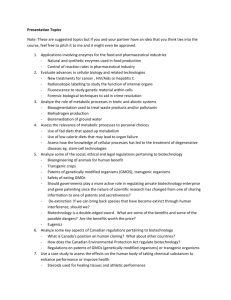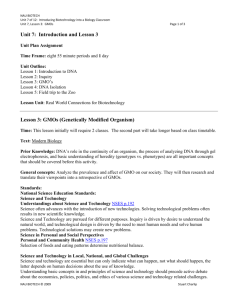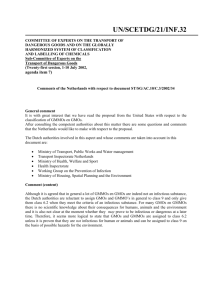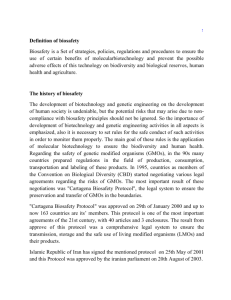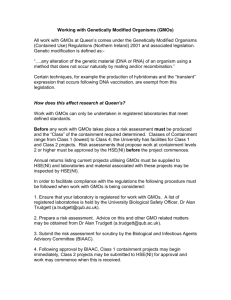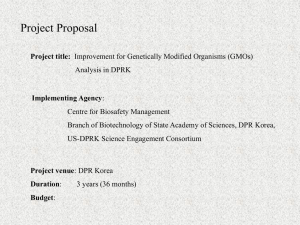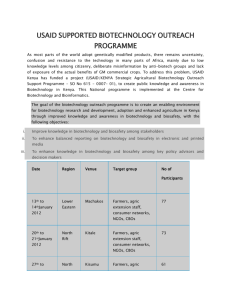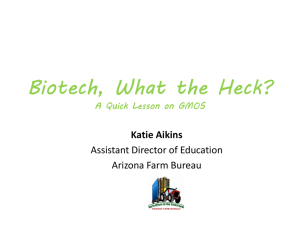The Biotechnology Policy and Biosafety Mechanisms for
advertisement
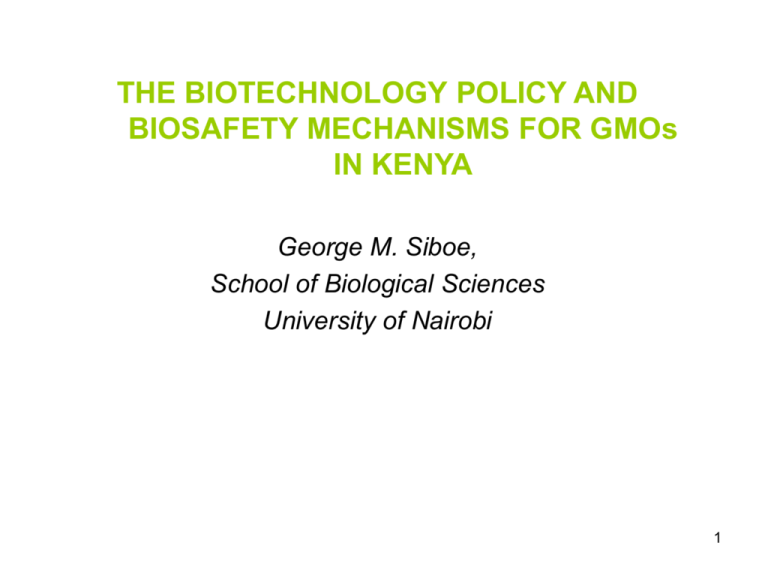
THE BIOTECHNOLOGY POLICY AND BIOSAFETY MECHANISMS FOR GMOs IN KENYA George M. Siboe, School of Biological Sciences University of Nairobi 1 • EXPERTS SOUND ALERT OVER RISING CASES OF DIABETETES IN KENYA! – More than 1.2 million people suffering from diabetes (Charity Ngilu, 30th june 2007) 2 I. INTRODUCTION Purpose of this presentation • To outline Kenya’s policy on biotechnology with specific reference to GMOs. INTRODUCTION 2. To outline the biosafety framework against which decisions are made about the activities involving GMOs in Kenya. 3 The biosafety Framework for GMOs: What is biotechnology? • Biosafety refers maximizing on benefits of biotechnology as we ensure protection to human health and the environment from possible adverse effects of the products. • The Genesis: • The 1975 Asilomar `Declaration’: Scientists at an international meeting expressed concern over the potential effect of modern biotechnology and designed strict restrictions on the use of recombination (r DNA) techniques. – Consequently, International conventions and protocols came into being to implement and enforce the scientists’ recommendation on rDNA techniques (Gene technology). Example (Gartagena protocol). 4 The Instruments of the National Biosafety Regulatory Framework 1. The proposed Biosafety Act, 2007 2. The National biotechnology Policy, 2006. – Guidelines on handling requests involving GMOs. – Guidelines on inspection and monitoring of GMOs. 5 II. KENYA’S POLICY ON BIOTECHNOLOGY • In principle and Practice, Kenya has adopted Gene technology for purpose of: – Improving the quality of human welfare. – Maximizing productivity in Agriculture and industry – Protecting the environment. • BUT ensuring that the application of the technology and the use of products are safe to human health and the environment 6 The Policy ---• Institutionalizes scientific risk assessment and management as a basis for approval of GMOs for research field trail and commercialization. 7 The Policy ---• Provides clear principles on following priority areas:- 1. Agricultural biotech: - to adopt productivity enhancing biotechnology. 2. Education: - to strengthen science education because biotech is a knowledge–driven and research intensive industry. 3. Bioresources: - To use biotechnology interaction to exploit the rich biodiversity and traditional knowledge associated with it for industrial product development. 4. Environmental Biotechnology: • To use appropriate biotechnology to address: (i) Environmental pollution. (ii) Eco- restoration for degraded habitants. (iii) Aforestation and reforestation (iv) Bioremediation of waste 8 The Policy ---- 5. Medical Biotechnology • To use the crème technology for development of – – – – – – Vaccines Vitamins Hormones Gene therapy Diagnostic kits Development of traditional herbal medicines into superior industrial therapeutic products. 9 The Policy ---- 6. Industry and trade: • The focus is to use Gene technology for value addition to primary commodities e.g. conversion of local bioresources into: – Biofuels – Biofertilizers – Pharmaceuticals – Food processing products 10 The Policy ---• The policy provides guidance to key issues that need attention in order for the country to gain a strategic position in modern biotechnology platform, and these include:1. Capacity building and mobilization of resources: – Human resource development – Infrastructure, facilities and equipment – Prioritization and co-ordination of research and development – Financial and business support 11 The Policy ---• Public protection and support: 1) Intellectual property rights • Government fund to support the filing of patents. 2) Protection of traditional knowledge and resources • Emphasizes royalties, patenting, access to information and benefit sharing of profits from biotech. 12 The Policy ---3) Products from GMOs:• All products containing engineered genes or derived from GMOs must meet requirements of the laws of Kenya governing:– Biosafety (The proposed biosafety Act 2007) – Environment (EMCA) – Sanitary and phytosanitary standards (P/Health, KEPHIS, DVS & KEBS) – Food and pharmaceutical standards (P/Health) • Release of GMOs only after careful and comprehensive Risk Assessment and ethical considerations. 13 The Policy ---4) Public education and awareness : – To create balanced public awareness on biotech issues and investment opportunities. – Ensure access to information on development of biotech held by public authorities – Ensure public participation in decision making process. 5) Ethical issues • Kenya will not allow the use of science to propagate unethical practices e.g. socially negative trends in biotechnology development like: – – – Human cloning Use of stem cells obtained unethically Introduction, use, or release into Kenya of any GMOs that have terminator gene sequences 14 III. Biosafety legal instruments and process for the regulation of GMOs Why do we need a separate legislation to regulate GMOs? 1. To provide for measures to promote the responsible development, production and use of GMOs. – E.g. The proposed Biosafety Act 2007 demands that Approvals of activities involving GMOs for containment use, introduction into the environment, placing on the market, or in transit must be preceded by a Science-based RISK ASSESSMENT of any effects on human health and the environment. 15 Why separate legislation-------2) Ensures that more information is made public e.g. Assessment reports on the suitability of GMOs for marketing. 3) Facilitates efficient and transparent decision-making process on GMOs for Kenya to benefit from biotechnology investment. 16 The Procedure for Handling requests involving GMOs in Kenya Application to NBC (NBA) secretariat IBC Relevant experts screen for completeness Secretariat acknowledges Receipt (May request for additional information) Risk Assessment by Experts Report to NBA NBA decision to allow or not to allow. 17 The procedure for the analysis of risk from GMOs Applicant lodges application with NBC: Technical Screening: Hazard identification Science-based Risk assessment Risk Management Plan Risk management - Giving effect to Plan: 18 Technical Screening: Risk assessment We Analyze and evaluate the risks by: Assessing the probability of harm from human or environmental exposure to each hazard Identifying possible consequences to health or the environment from exposure to each hazard Assessing the level of certainty of the estimates Identifying risks that are consequential and which are not of any consequence Risk management - Giving effect to Plan: Pre- conditions: Training, prepare site, upgrade facilities etc During & after project/release: Monitoring, usually by the applicant Surveillance/inspection by Regulatory Agent for compliance with legislation and conditions (Each ensuring that the project or product is not causing significant/unanticipated impacts on health or the environment during project & until impacts are no longer likely.) Hazard identification Identification of types and sources of hazard to human health or environmental? Ensuring that all hazards are identified Risk Management Plan We consider: Available options to remove or mitigate each of the risks of consequence Whether the level of risk that remains is acceptable Whether the steps required to remove or mitigate the risk are acceptable and/or feasible Then: Decline to allow activity as too risky; OR Set out risk management requirements for allowing application to proceed 19 DON’T WORRY, BE HAPPY-----. THANK YOU 20
